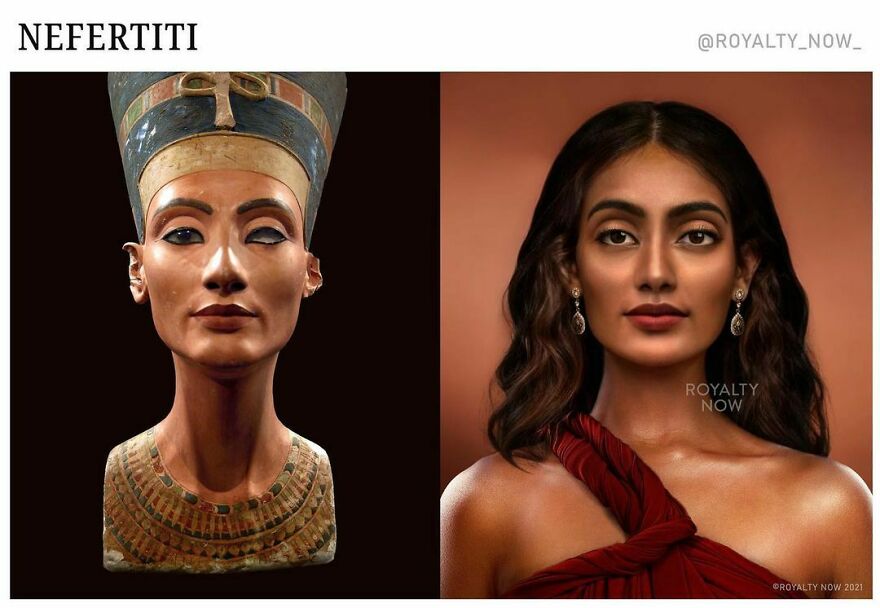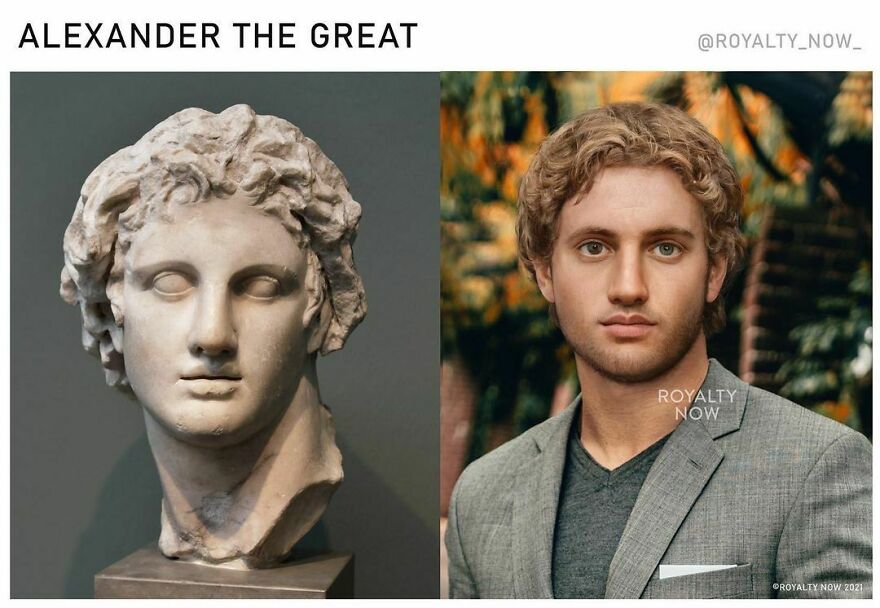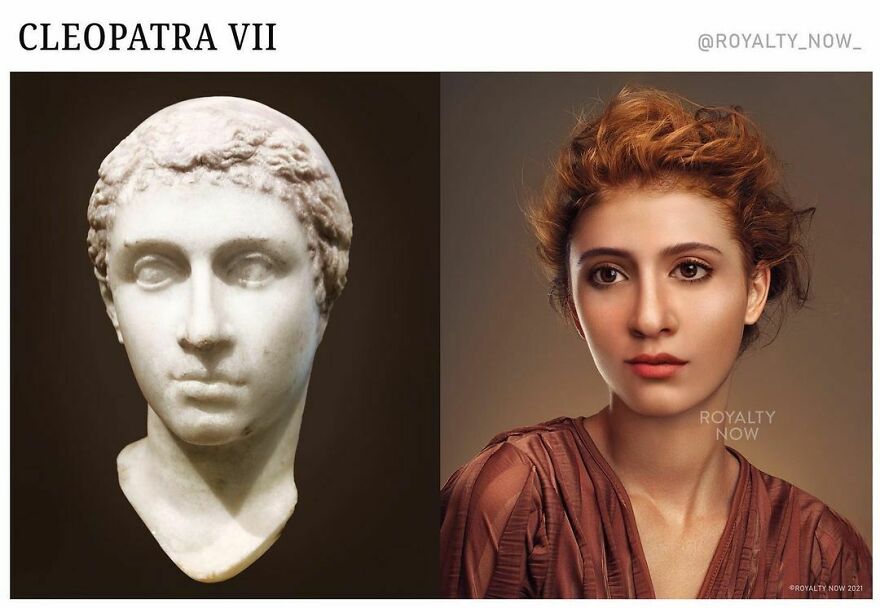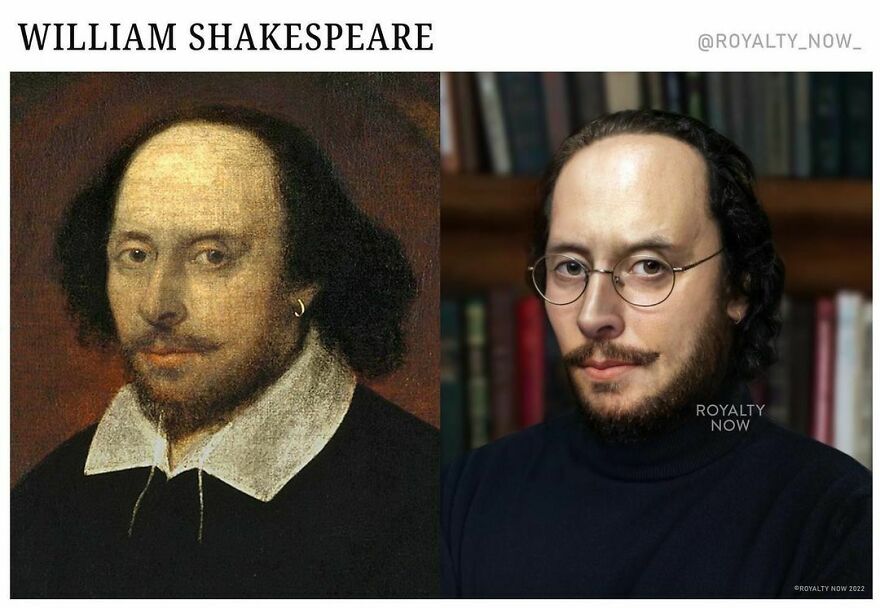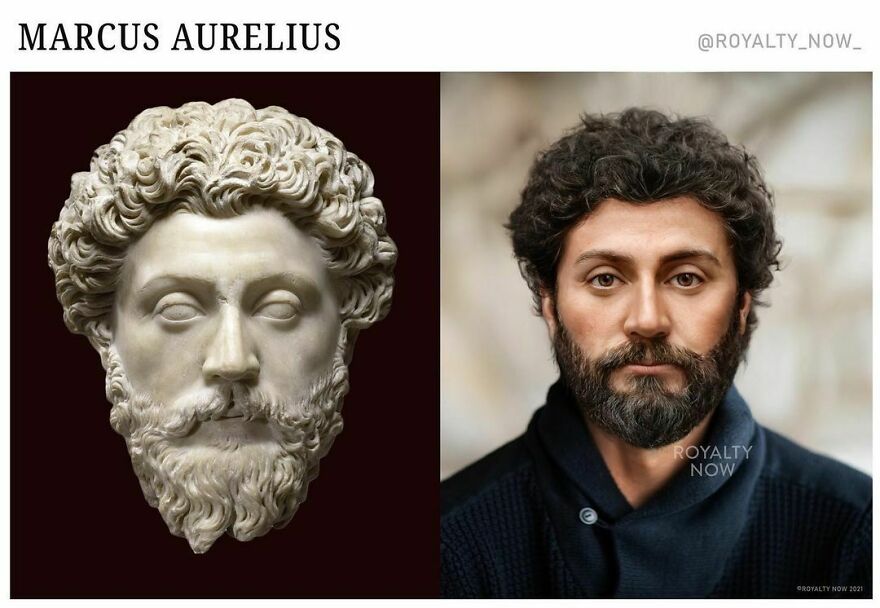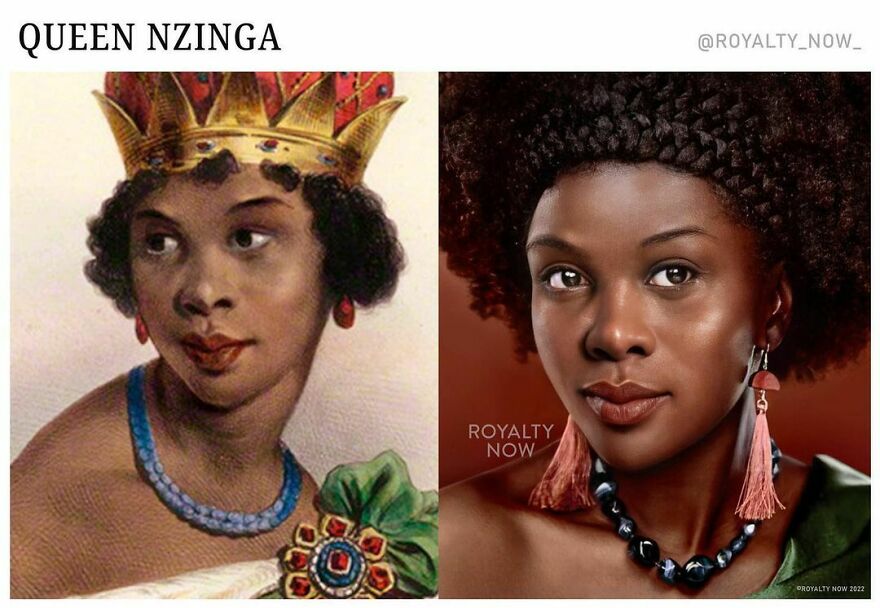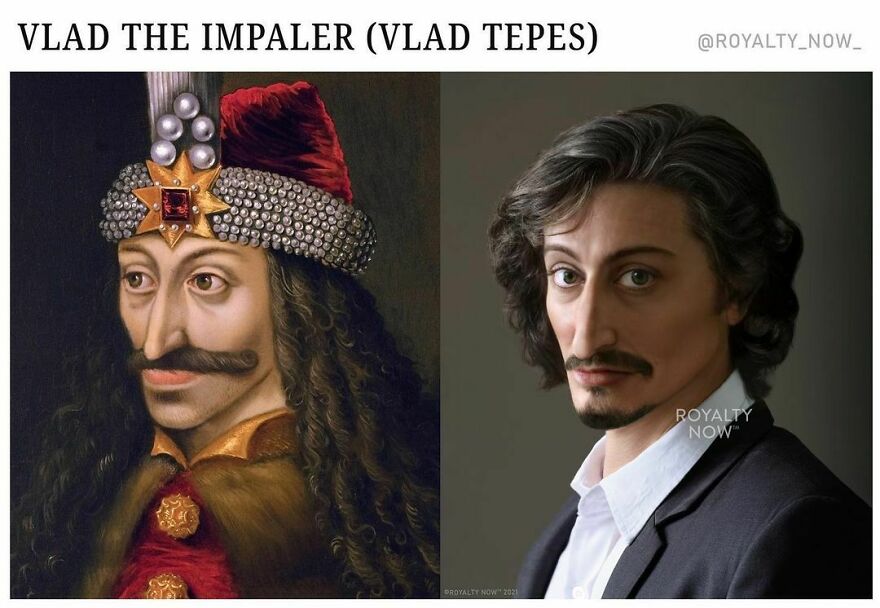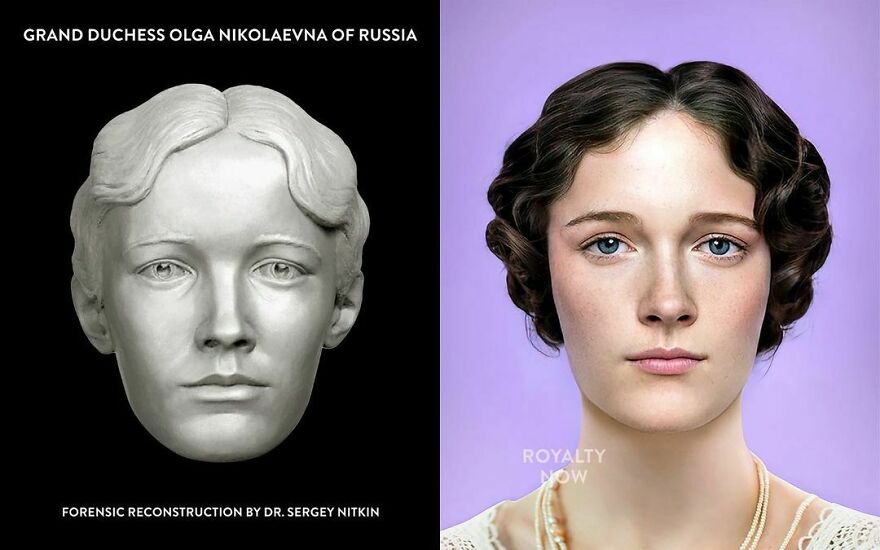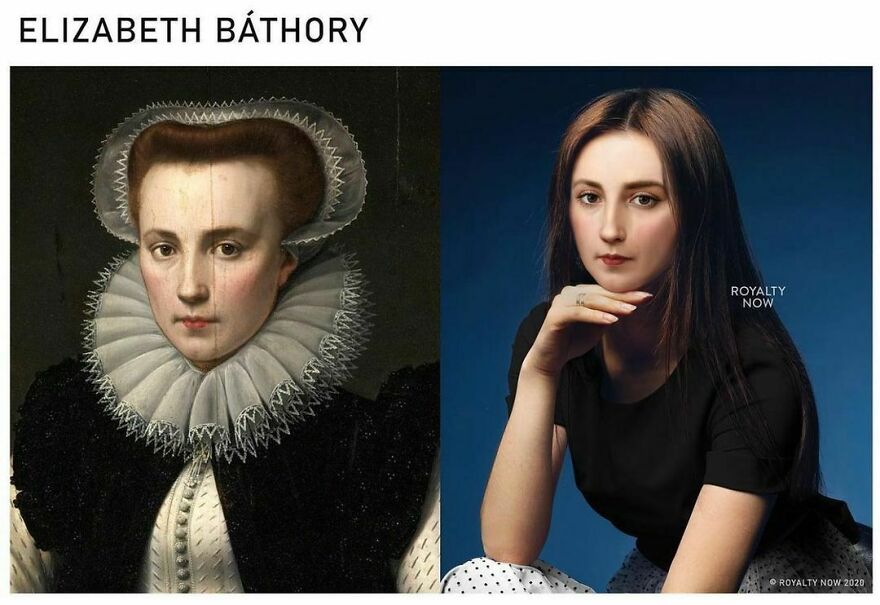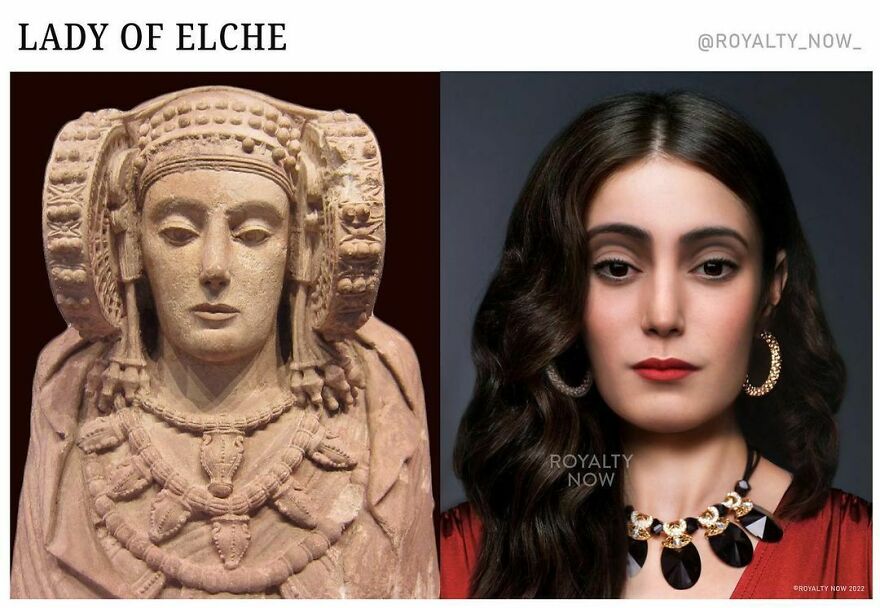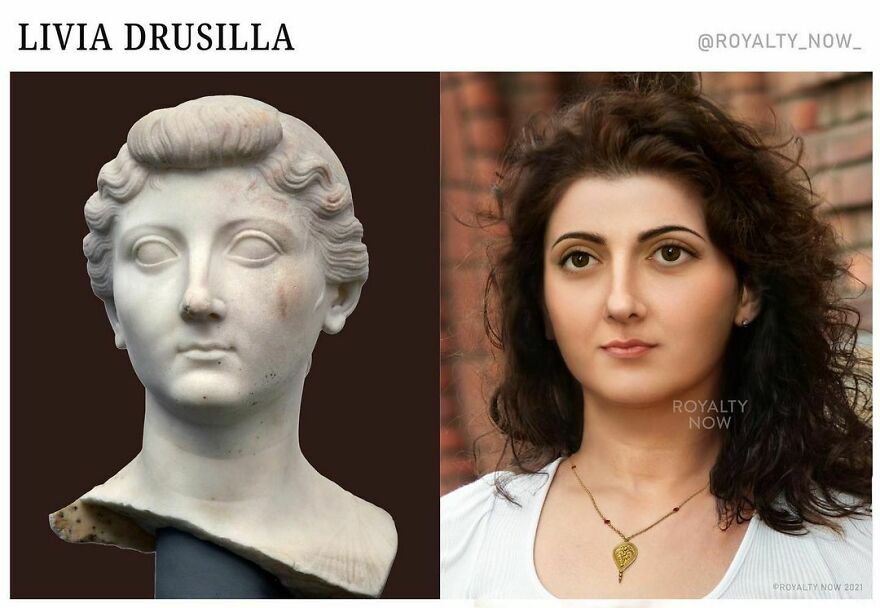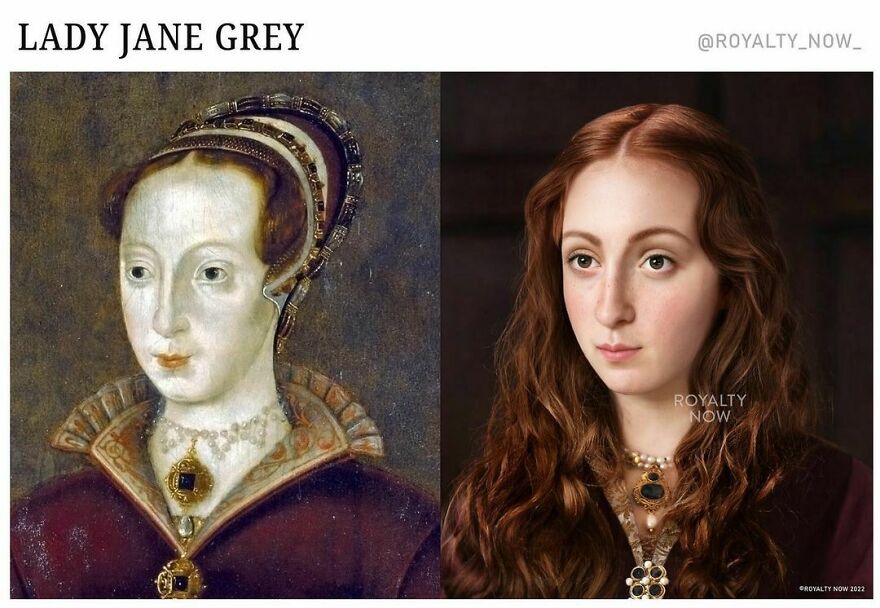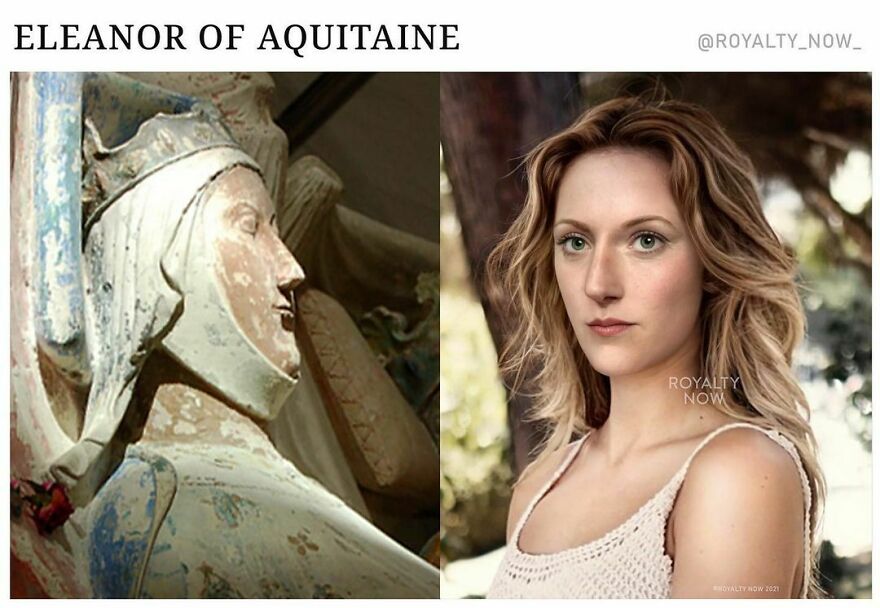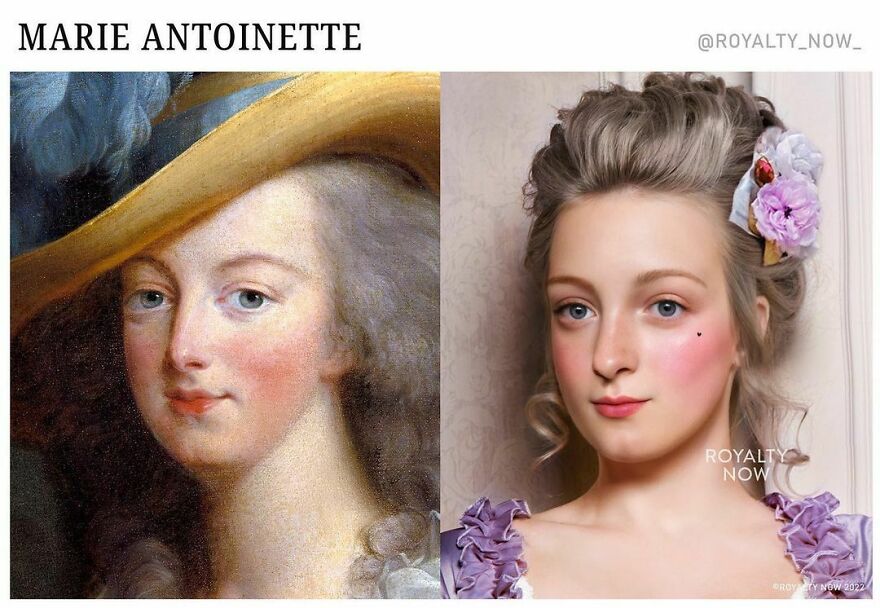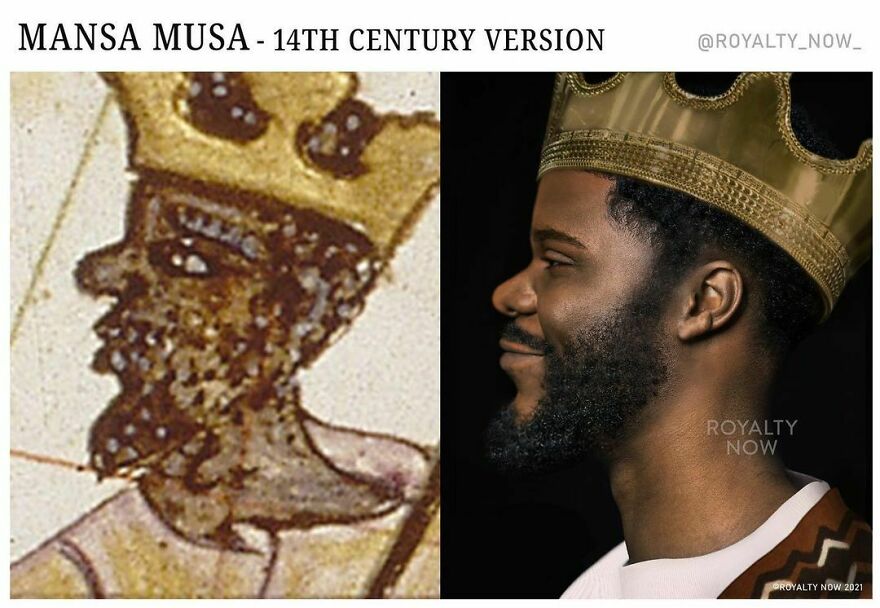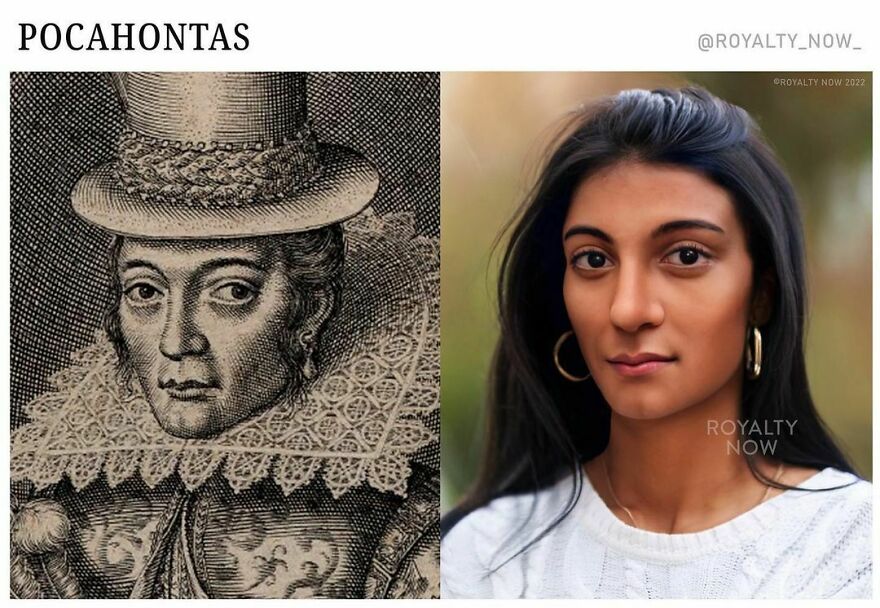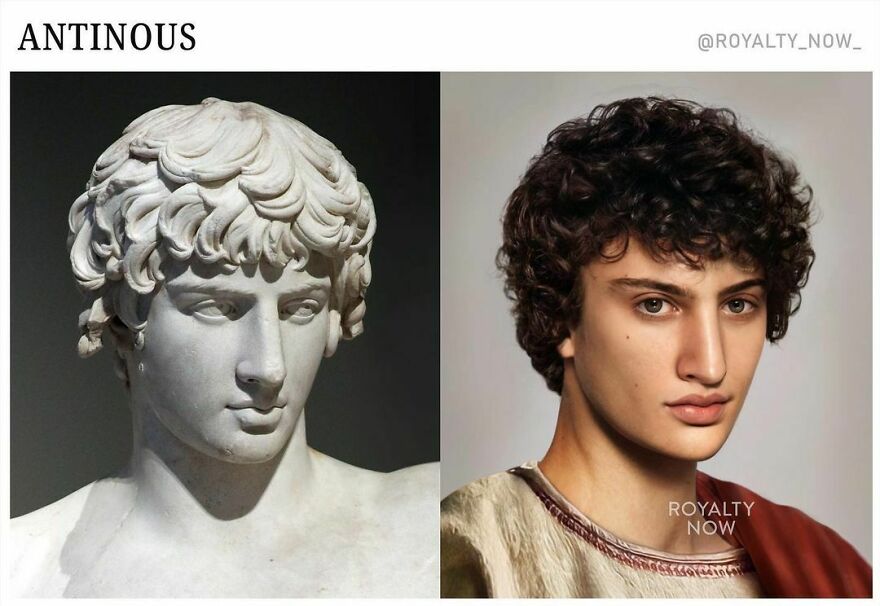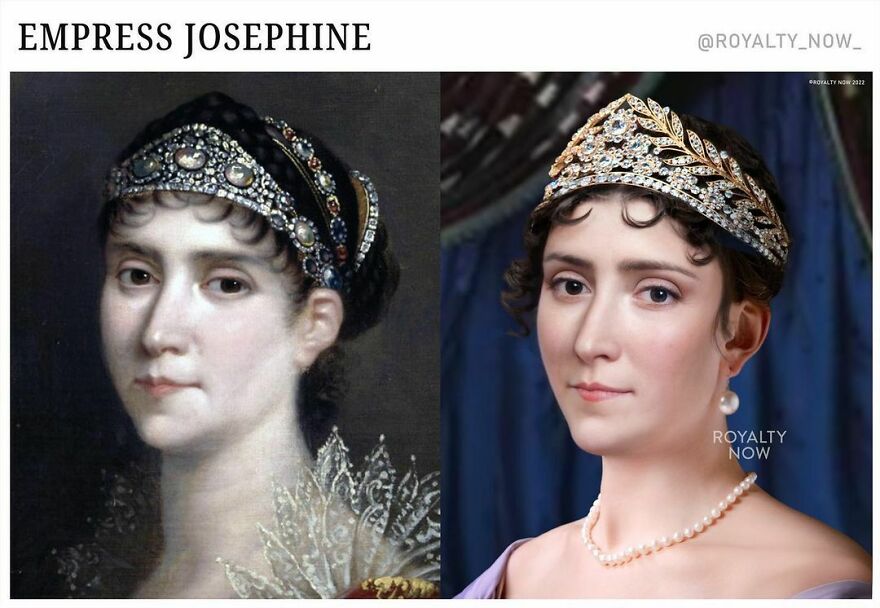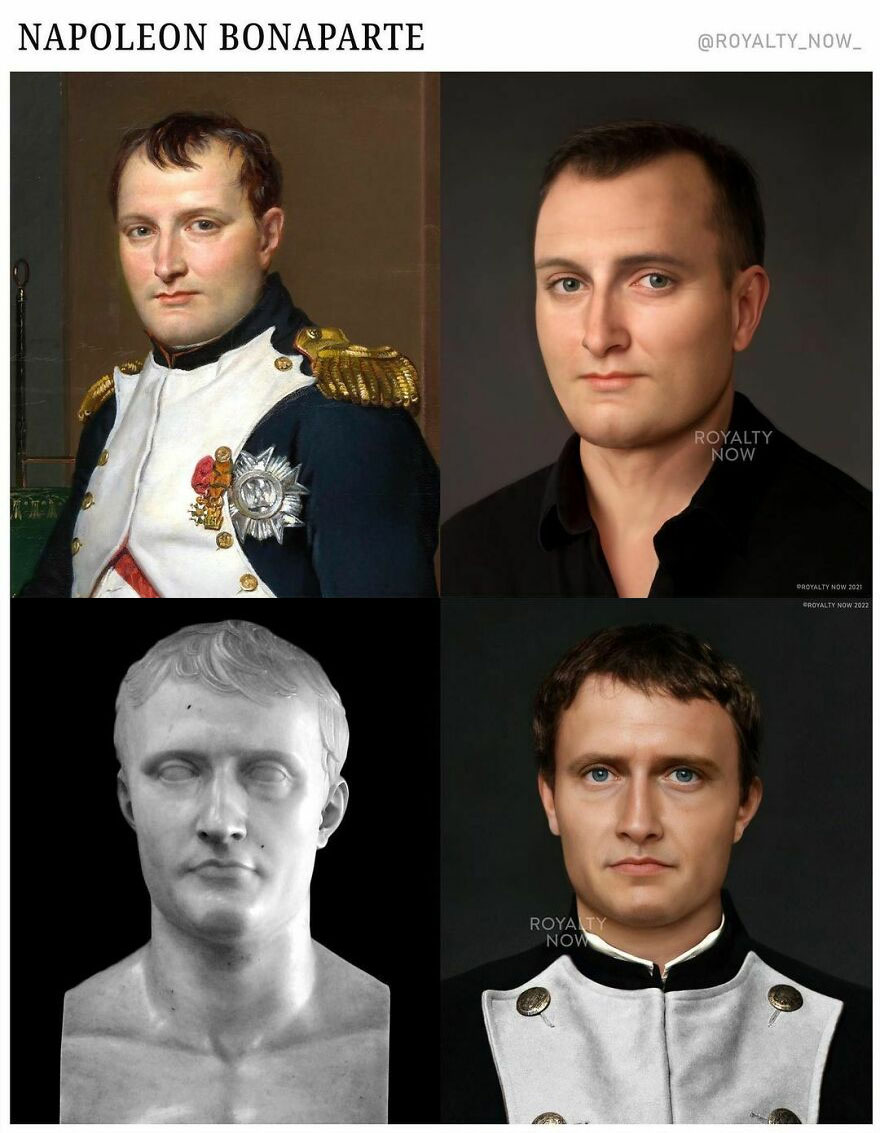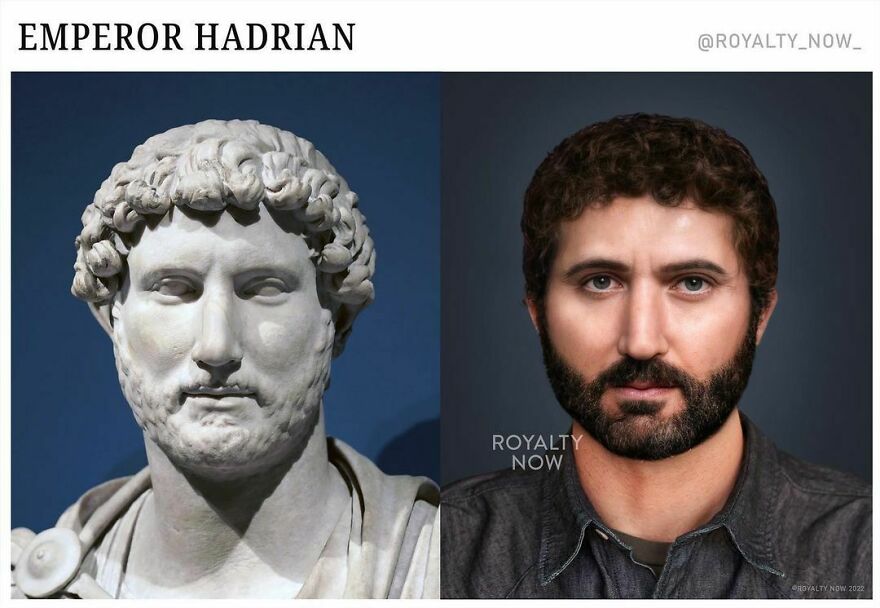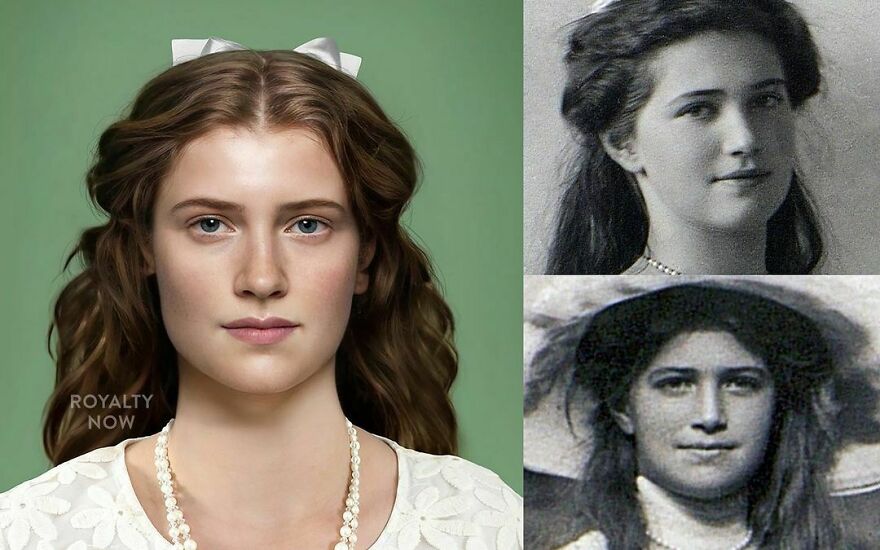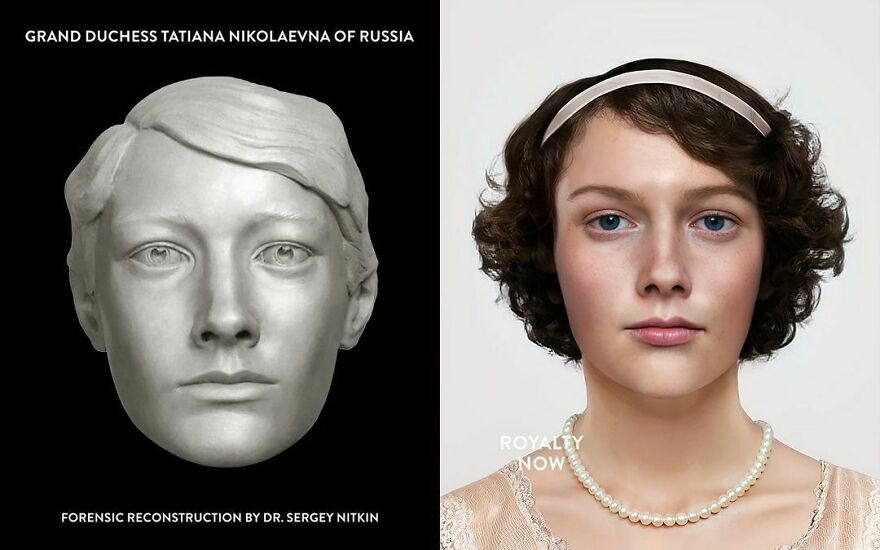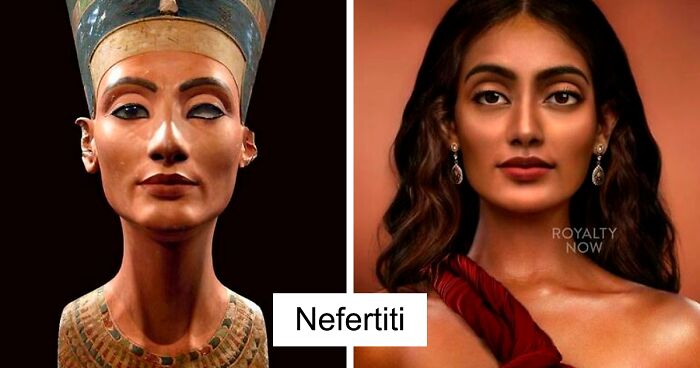
Here’s What Napoleon And Others Would Look Like If They Were Alive Today (22 New Pics)
There are many people we can recognize without personally knowing or having met them. Einstein with his iconic hair and mustache or the beautiful features of Marilyn Monroe, to name just a couple. Oftentimes, we familiarize ourselves with their appearance through pictures, but how do we visualize historical figures that didn’t leave a lot of them for us to view?
There's no need to push your imagination into overdrive speculating what they would look like nowadays. Becca Saladin has yet again successfully covered that for you. She has breathed new life into some more portraits of historical figures, which we can’t wait to share with you. Scroll down to see what you would encounter if you met Napoleon Bonaparte or Alexander The Great on the street tomorrow. Below you will also find Becca’s thoughts about the research and some of the challenges she faces while working on the portraits, which she revealed to Bored Panda during a recent interview.
Becca’s Instagram account has already attracted over 370 thousand followers (we recommend you to join them). If you want to learn more about her journey with this beautiful idea, make sure to check here, here, here, and here.
More info: Instagram | Facebook | Youtube | TikTok | Etsy | Patreon
This post may include affiliate links.
"There are dozens of images of Alexander that can be viewed all around the world, including coinage, busts and full-bodied statues. Despite the wealth of imagery we have today, most are assumed to be later copies of lost originals. It’s clear that depictions of him were idealized in the Greek style.
So what would he look like if he were to appear in front of us today? Firstly, Alexander was what we would now think of as a modern Greek man. He was born in Pella, Macedonia, which is near the top of the modern-day Greek peninsula to parents who were both from Greek kingdoms. Descriptions of him from his lifetime mostly agree that he had blonde or golden hair, fair skin that may have been a bit red, and a handsome face with a prominent forehead. He was also stocky and muscular, and may have only been just over five feet tall. An interesting fact about his appearance is that he may have had heterochromia, a condition where the eyes are two different colors, or a speckled combination of both. I’ve given him a brown spot in his right eye to reflect this engaging narrative."
The mastermind behind the project, Becca Saladin, told Bored Panda that a lot of work is done before even starting the portrait itself. “Since we make videos with the full history of each subject along with the re-creations, our research is extensive. I like to get a full bio of each person before beginning the reconstruction. I also specifically look for details about their appearance,” she said.
“You'd be surprised by how many portraits from the past weren't created while the subject was even alive, or are copies of lost originals,” Becca pointed out. “I like to research what people said about them during their own lifetime, and then of course find the most accurate portrait of them. I try to always use images created during the figure's life, but sometimes I have to go based off of more physical descriptions if they don't have a reliable portrait.”
"Was Cleopatra a red head? I have to admit I was fairly against this idea for a while, considering she was probably at least 75% Greek and Middle Eastern - my mind automatically went to dark hair. However, I wanted to do some additional research and present a red-headed version of her from the Berlin Bust, which I believe is a fairly accurate likeness of the Egyptian Queen.
The evidence for her being red-headed lies in a couple of images that aren’t confirmed but very likely could be Cleo. These are some frescoes from Pompeii and Hurculaneum, as well as a cameo image that was made around her lifetime showing her with vivid red hair. Descriptions of the Fresco from Dr. Joann Fletcher: "Painted image from a villa at Herculaneum portraying a red-haired woman whose facial features, royal diadem and hairstyle adorned with fine pearl-studded hairpins suggest a posthumous portrait of Cleopatra VII." So what do you guys think?"
"There is no provenance to this painting, but if it is Shakespeare, it would be the one and only likeness of him taken from life. Here are some reasons why it might be him: The clothing the subject is wearing was popular between 1590 & 1610, the time when Shakespeare was having his greatest successes and therefore most likely to sit for a portrait. The gold earring suggests a “bohemian” appearance - common for a playwright. We can tell the subject is of reasonable wealth because of his all-back clothing. Black dye in large quantities was quite expensive.
I also wanted to share another exciting collaboration between KLEIO and Royalty Now: Introducing A Midsummer Night’s Dream. This candle takes inspiration from its namesake, one of Shakespeare’s most celebrated plays—and recreates the fragrances of a well-known scene.
The thing I find fascinating about this candle is that these are all scents that Shakespeare would have been familiar with in his lifetime. In fact, it may even encourage you to experience Shakespeare’s plays in a new way…and gain a fresh perspective on how he incorporated the senses into his work."
"The “Philosopher Emperor” - such a highly requested figure.
Marcus Aurelius was Emperor of Rome for 19 years from 161 - 180 AD. He ruled at nearly the height of the empire, with 70-80 million subjects, nearly one fifth of the population of the earth at that time. He is famous for the Germanic Campaigns, as well as his book of stoic musings, called “Meditations,” that contains super pertinent bits of philosophy still used today. Unfortunately, Aurelius was the last of the “Five Good Emperors,” a string of good rulers that would eventually break thanks to Aurelius’ son Commodus. His reign is sometimes considered the tipping point between the glory days of the Empire and the beginning of the Fall of Rome.
Although we don’t know anything about his hair or eye color, we know that he is of Italian and Spanish heritage, so some guesswork definitely goes into this. Most other recreations I’ve seen give him tan skin and dark hair & eyes. Luckily there are many statues of Aurelius to work from, all sharing the same features."
Becca shared that, when it comes to clothing, hair and other style-related details, the result is based on her initial instinct after reading about the subject. “I like to figure out how they were during their lifetime (were they modest? Were they pious? Were they considered fashionable or dashing?) and then I go from there. The modern-day versions are just meant to be fun, so I go with my gut on styling these.”
She also admitted that getting the clothing just right is pretty difficult at times: “It can be really hard to cobble together something like a Tudor-style outfit just using the historical sources available online.”
"Nzinga is one of my favorite women in history. She lived a fascinating life that is not recounted nearly as often as it should be. I have an old version of Nzinga, but I wanted to recreate her because I don’t feel like I did the portrait justice the last time.
Nzinga was the warrior ruler of the Kingdoms of Ndongo and Matamba, which now constitute modern-day Angola. She spent her life in on-and-off warfare with the Portuguese, trying to protect her people and the rest of the African interior from slave raiders. You can check out the full history of her life and the timelapse recreation of her portrait on the YouTube channel - Royalty Now Studios. With a reign lasting 37 years, she continues to be an Angolan hero to this day.
So what did she look like? Unfortunately we don’t quite have a contemporary portrait of her - what we do have is a copy of a lost original sketch.
This portrait is a version made by a French Lithographer in the 1800s. It’s based on original drawings completed by Giovanni Cavazzi during his travels to Portuguese Angola. I discovered some quirks that made it difficult to work from. It’s very very difficult to describe just how weird this portrait is, especially not until you’re the artist trying to reconstruct it. The face is painted at a strange angle to the neck, and the nose and mouth are painted from almost two different perspectives. So I had to do my best to translate this into a believable rendering, and a few changes were made. I created kind of a past-and present hybrid image of Nzinga that I really love. Let me know what you think!"
"Gotten a lot of requests for this one lately, thought it would be a great time of year to do Vlad Tepes, also known as Vlad the Impaler, the loose inspiration for the character of Dracula.
There is plenty more research you can do on Vlad’s life, but let’s talk about what he looked like! It’s important to note that there are no known contemporary images of Vlad Tepes. This portrait was painted in the 16th century, long after his death, by an unknown artist. It is perhaps thought to be a copy of a lost original. Some think that it was even painted by his enemies, as a cartoonish way to make him appear more evil. There is also a small painting of a man that is thought to be Vlad from the altar of the church of St. Maria, Vienna, painted in the year 1460 (see next slide).
We also only have one description of him, from Niccolò Modrussa, a papal legate. Niccolo describes Vlad as stocky, strong, with a cold and terrible appearance. He had a strong aquiline nose, a thin face, with very large green eyes. He also had a strong neck, black curly hair, and wide shoulders."
On point, he looked exactly like this when we met 500 years ago
"Today I’m going to start with the oldest daughter in the family, Olga. She was just 22 at the time of her tragic death in 1918. In 1979, the first Romanov gravesite was discovered, in the woods outside of Yekaterinburg, where the family lived out their final days. But because of the secrecy in the Soviet Union, the bodies were not exhumed and examined until 1991.
The first gravesite was found to include the bodies of Tsar Nicholas, Tsarina Alexandra, Olga, and 2 other daughters. It also included the bodies of 3 of the family’s personal attendants.
Olga was the first daughter whose remains they were fully confident identifying - she was quickly matched with Skeleton.
It’s emotional to make these lifelike reconstructions. While we have many photos of the whole family, they are surprisingly low quality and grainy. Of course it’s not shocking that the forensic construction matches very closely to what Olga looked like in photographs, it brings us a step closer to seeing her humanity. I had such a great time working on this series."
Why would you want to "reconstruct" her face when there are many actual photographies of her? They may be low quality and grainy, but that was state of the art during her lifetime.
When asked about some of the most challenging portraits, Becca chose Marie Antoinette as an example. “She is really interesting because she has a death mask, but it was obviously created at the end of her life when she was grieving and imprisoned.
“So you have to compare the death mask to portraits of her during her lifetime, many of which change her features a lot based on 18th century beauty ideals. For some of these figures I have to correct quite a bit for the stylizations of the time, which can be challenging to guess,” the artist said.
"Throwback to last Halloween’s post: Elizabeth Bathory. Legend has it that she is one of the most prolific serial killers of all time, operating in Hungary in the early 1600s. Some also say she is a framed innocent - such an interesting story!
A note that this is made from an unconfirmed portrait of Bathory - “portrait of an unknown lady” by Anthony Blocklandt, commonly associated with the legend of Bathory."
"The Lady of Elche has always fascinated me, with her interesting headdress and delicately carved face. It turns out the statue is quite mysterious as well. Discovered in 1897 at a private estate south of Elche, Spain, it is generally thought to be an Iberian artifact from the 4th Century BC. However, originally scholars discounted it because they believed the artisanship doesn’t quite match up with other Iberian artifacts from that period. She is believed to be a goddess, Tanit, who was worshipped by the Punic-Iberians in ancient times. However, some scholars argue the sculpture’s design and style suggest some Hellenistic influences. Originally, the bust was brightly painted, with reds, blues and yellows.
The mysterious nature and inability to quite place it in Spain’s history have stirred up speculation that it is a forgery. However, more and more discoveries of other artifacts in recent years have all but proved this false. The Lady of Elche was actually the first Iberian sculpture discovered that was brightly painted, which originally made it stand out, but recent discoveries show that that was not uncommon after all. The trace pigments on the statue are consistent with ancient materials and paints.
Conspiracy theorists have even said that it is a lost Atlantean artifact. Her “rodette” headdress could in fact be a link to the concentric circles associated with the lost city.
There is an interesting hole in the back of the sculpture, that may have originally contained human ashes. This led scholars to conclude it was likely a funerary urn. Whether or not it was intended to represent the deceased human however, is up for debate. Still a fun one to work with!"
Becca told Bored Panda that her re-creations are a fun way to bring history to life. “All I hope is that history feels more tangible to the people who see them—a reminder that the past was real, and happened to real people.”
"I got a flood of requests asking for Livia after I completed her husband Augustus a few weeks back. I’m really glad I got the chance to research her, she is such a fascinating character! Livia is best known for being the influential wife of Augustus and mother to Tiberius. Livia doesn’t have the best reputation - the Roman historian Tacitus has said that Augustus was completely under her control, that she had every heir to the throne who would challenge her son either banished or killed, and that she was utterly manipulative. However, she was an incredibly loyal wife and partner. She had her own business ventures and had a significant influence on her husband’s affairs. She was considerably generous when encouraging Augustus to be merciful to his political opponents. Livia is very much an interesting character of history who can be seen from many perspectives. Unfortunately I couldn’t dig up any information on her hair, eye or skin color. This is certainly just my artistic interpretation of her appearance."
Her face looks like she belongs in an oil painting :o
"Verified
Lady Jane Grey is a figure I’ve touched on before, and I made a modern version of her last year. We just recently made a full YouTube video about her life and appearance, check that out at Royalty Now Studios (link in bio), so I created this “in her own time” recreation for that video. I wanted to recreate her also from the Streatham portrait, which is said to be the closest possible link to Jane. It’s still disputed as a true likeness of the Nine Day Queen, but is generally accepted as a somewhat poor copy of a lost original. It dates from around 40 years after Jane’s death, and includes a “Lady Jayne” description, as well as clothing that matches Jane’s era.
Lady Jane Grey was 4th in line for the throne when she was born around October of 1537, but I’m sure that she never expected it to come down to her. King Henry VIII and Jane Seymour had just welcomed their son Edward that same month, and they were obviously expecting him to be the future King. Jane was raised as a ward in the household of Catherine Parr and Thomas Seymour. Catherine and Jane bonded over books, their Protestant faith, and their shared love of learning. In 1553, Jane was arranged to marry Lord Guildford Dudley, the son of the leader of Edward VI’s regency council.
At the age of 15, King Edward fell ill. Edward made a document that he called his “Devise for the Succession,” which had many revisions, but upon his death it skipped both of his half-sisters Mary and Elizabeth, and gave the 16-year-old Lady Jane Grey the crown. Like Jane, King Edward VI was a devout protestant and he desired that England remain a Protestant country. This left Jane in an incredibly dangerous position.
The reluctant and terrified Jane only reigned for nine days before Mary I came to claim the throne. Jane and Guildford were soon arrested and locked in the Tower of London. On February 11, 1554, Lady Jane Grey was executed at the Tower of London.
Jane’s strength and steadfast faith at the end of her life make her an admirable figure, and she has been viewed as a Protestant Marty for centuries."
"Super excited to show another “artistic” version of a famous figure, especially since you all request her so often: Eleanor of Aquitaine. Eleanor is the famous Medieval Queen of the 1100s who is remembered for her beauty, personality, and iron will. She was a truly incredible woman who desired independence, power, and the freedom to make her own choices. She is famously the Queen of King Henry II and the mother to King John and Richard the Lionheart.
Now in the case of Eleanor, we have no true images of her. She lived before the time of realistic portraits being painted. There are many romantic images of her that have been painted throughout the years (see next slides), but there’s really no way they can be accurate. The closest thing we have to accuracy for the nearly 1000 year old queen is her tomb effigy from Fontevraud Abbey, which she may have had a hand in designing. It shows a tall, thin woman, with long and somewhat sharp features. Since we lack even any references to her hair or eye color, what I’ve done is create an artistic interpretation of her, based on several of these images of her.
Of course it’s normal for contemporaries to laud the beauty of their queen, but it seems that in Eleanor’s case, she was truly the jewel of Aquitaine. She was described by a traveling musician as being “The embodiment of charm...with lovely eyes.” A German poet who briefly caught sight of the Queen writes: “Were all the world mine / from the sea to the Rhine / I’d give it all / if so be the Queen of England lay in my arms.”"
"There is actually a death mask of Marie taken soon after her execution. It was taken by a wax worker whose name you probably recognize: Marie Tussaud. Tussaud got her start during the French Revolution, taking masks of the dead as a sort of real-time commentary on what was going on. Marie was in her late thirties when she was executed, and I’m sure completely worn down by the stress of the revolution. I wanted to combine the features of the death mask with those of the portraits, and create a version of Marie Antoinette as Queen in her prime. She still had the same downturned blue eyes, but they look more normal in proportion. Her nose is a bit more hooked in real life than in the portraits, and her lips are more flat, without the pinched, stylized look of the lips in the paintings."
"The richest man that ever lived? This is the refrain that is most associated with Mansa Musa, the Mali ruler from 1312 - 1337. I wanted to make kind of an artistic version of Musa I, for whom unfortunately only this one near-contemporary depiction exists. This image is from the Catalan Atlas, which was illustrated by a Jewish Illuminator, Cresques Abraham, who was unlikely to have seen Musa in person. It shows him in a European-style crown and holding a nugget of gold. He’s such a fascinating figure, I really wanted to represent him somehow, even if it meant taking a lot of artistic liberties. What I’ve done is create a version of him from his own time, and then another of the same man in the modern day.
We do have some loose descriptions of him by contemporaries, which describe him as “A young handsome man.” and “[a] young man, brown skinned, with a pleasant face and handsome appearance”."
"Pocahontas is such a fascinating figure, I forgot how much I loved American history until revisiting this one. I didn’t have room to write a full historical summary here, so make sure you check out the new YouTube video on her (link in bio and story) for the full history and animated image reveals.
This is the only contemporary image of a young Pocahontas (real name Matoaka - Pocahontas is a childhood nickname that stuck), commissioned by the Virginia Company after her visit to England with her husband John Rolfe in the early 1600s. Engravings aren’t typically the most flattering forms of art, and this one makes her look much older than her 20 years. But I do think her true likeness is definitely in there - you can still see her Native American features. Her features line up very distinctly with the descriptions of the Powhatan - that they have very strong cheekbones and jaws. They are also said to be naturally more pale than other Native American groups, but that they got very tan in the sun, with long straight black hair and black or brown eyes (H.C. Rountree)
For the 1600s version of Pocahontas, I researched how Powhatan women typically dress and how they adorn themselves. Like many Native American cultures, the Powhatan wear clothing, adornments and tattoos that are based on age as well as gender. It’s hard to tell exactly what tattoos Pocahontas would have had in her own time, so I’ve used a tattoo pattern that is fairly common. Powhatan women wear deerskin dresses or aprons, and they are often decorated with shell beads. They wear necklaces and other jewelry to suit the occasion, and wear their hair long and free, or in a single long braid. I really, really love this version of Pocahontas."
The features are a bit off comparing it to other pictures of Powhatans.
Unfortunately, we don’t know much about Antinous’ life until he pops up in the history of Hadrian’s. We know that he was raised in Bithynia (modern-day Turkey). He probably met Hadrian at a young age, around 12 or 13, when Hadrian sent him to become a page and educate him in Rome. However, their romantic relationship probably didn’t begin until Antinous was 17 or 18 - there is still a huge age gap between them, though. Antinous was considered Hadrian’s “favorite” by 128 AD, and was taken on a tour of the Roman Empire as a member of Hadrians’ personal party. Hadrian was very, very attached to Antinous - sadly we know nothing about Antinous’ true feelings for the Emperor. In October of 130 AD, the couple was taking part in the Festival of the Nile on a boat in Egypt. After the festivities, Antinous’ body was found floating in the Nile. Hadrian himself stated that Antinous drowned, and was absolutely devastated by the news. This is, of course, a mysterious way for a 20-year-old to die. Historians suggest various theories such as accidental drowning, suicide, or even intentional human sacrifice.
Like Hadrian, surprisingly little exists about Antinous’ appearance. One source described his hair as “near-purple” which means either reddish or very dark black to me - I went with dark with a reddish tint for my depiction. He was ethnically Greek, so I’m inferring skin and eye color from that.
"Despite having many portraits created, Josephine’s appearance is a bit mysterious. Each portrait of her looks just slightly different. They all show a woman with delicate features - deepset eyes with visible lids, a long and sharp nose, and a small mouth with a pointed chin.
For my recreation, I used this version of her by Robert Lefevre, painted in 1805. For some reason this one looks the most real and natural to me, kind of finding a medium spot between varying depictions of her features."
"Shown here by Jacques-Louis David in 1812, Napoleon is the famous French political leader whose military campaigns are still studied today. I had a realllyyy old version of Napoleon that I won’t show ;) but I’m sure some of you have seen it. This is definitely an improvement."
"There was repeated sentiment from Napoleon’s contemporaries that portraits never seemed to quite capture his true likeness. A friend once wrote that “No one that ever lived had so many likenesses which generally bear some resemblance of feature and form. It was extremely difficult to portray or delineate Napoleon’s look.” We do have a lot of physical descriptions: It was said that he was very thin in his youth, but that he gained weight throughout his life. Others remarked that he had delicate features and piercing grey eyes. And of course, he stood around 5’7”, which was an average height for the time. Napoleon was also a master of propaganda, and he was very careful about which images of himself were released. His main concern was not portraying a true likeness, but portraying his power. For one of my recreations, I’ve used the bust of Napoleon by Antoine-Denis Chaudet. There were over 1,200 copies from the original plaster model that were disseminated throughout the empire as the official likeness of Napoleon. Now of course, he’s depicting himself as essentially a Roman Emperor, and although some said this was the most faithful image of Napoleon, I do suspect that there has been some stylization."
"Emperor Hadrian is a really fascinating subject I’ve been meaning to get to for a while. Emperor Hadrian was born in 76 AD, in Italica, which was a Roman province in Spain. He was only the second Emperor to be from a foreign territory. He rose to prominence in Rome, and was set to be the next in line for the Emperorship after Trajan. He was quickly married to Trajan’s grand-niece Vibia Sabina. However, his treatment of her was quite icy. Trajan’s favor of Hadrian kind of seems to sour at this point, and the succession seems back up for grabs. Hadrian’s icy treatment of his wife can now be explained by the fact that scholars almost all agree that he was a gay man. Hadrian famously had a lover named Antinous, who died tragically young and was even made a Deity. Hadrian and Antinous had a massive age gap, and while this was very common and socially acceptable at the time (an older man would generally take an interest in the education of a young man and help him become an accomplished adult), it’s hard not to see this as predatory through our modern lens. Hadrian did accomplish a lot during his time as Emperor - he built the famous “Hadrian’s Wall” - which he never even laid eyes on by the way - and completed several other large building projects. Unfortunately after Antinous’ death, he went off the rails a bit. While he previously engaged in peaceful policies, Hadrian put down a Jewish revolt very violently, engaging in an outright war. Hadrian did transcend the title of a “Good Emperor” - with many shades of gray existing during his time as ruler.
We don’t know too much about Hadrian’s hair or eye color, but it’s possible he had brown hair and gray eyes according to pigments remaining on some statues. There were dozens of images of Hadrian made, and they all look remarkably consistent with each other. It’s easy to see what his face really looked like. He probably did have curly hair, but Hadrian was really fond of Greek culture, and the busts of him have an exaggerated curly head of hair and beard as an homage to his favorite Greek philosophers."
"My last Romanov daughter: Maria. I have such a soft spot for the sweet, kind face of Maria. Although scholars still debate, I believe Maria was the body found in the second Romanov gravesite, found in 2007. There were no forensic reconstructions made of the 2 additional bodies, since they were found so much later than the rest. So I wanted to make a photo-composite version of Maria as well just to make sure she was represented."
Hers was confirmed to have been found along with Tsarévitch Alexei’s body in 2008. I’ll never forget reading those newspaper articles in my local papers as long as I live.
"Verified
Let’s take a look at my reconstructions of the second Romanov daughter, Tatiana.
Tatiana was another daughter found in the first Romanov gravesite, and her body was exhumed in the 90s. Nitkin’s forensic reconstruction of Tatiana is the only one that I find doesn’t really match her appearance in photographs. So I’ve made 2 re-creations for her - one that matches the forensic reconstruction, and one that is more of a photocomposite.
Of course, forensic models aren’t always accurate. I think Tatiana just has a face where her soft-tissue features really define her appearance, so she’s an interesting case study into the accuracy of forensic reconstructions. There are certain things that skull reconstructions can’t touch, like the soft-tissue features. The precise shape of the lips, Face fullness in certain areas, etc."
In a world where we often rely on photos to recognize famous figures, historical icons like Marilyn Monroe remain instantly recognizable, much like those imagined in science fiction. The creative works of Becca Saladin and the use of AI to visualize how Hollywood legends might look today are a testament to the fascination with both familiar faces and advanced artistic interpretations.
Exploring how the past is visualized today, these digital transformations offer a fresh lens on Hollywood's timeless allure.

 Dark Mode
Dark Mode 

 No fees, cancel anytime
No fees, cancel anytime 






